Great Lakes Basin Forest Health Collaborative
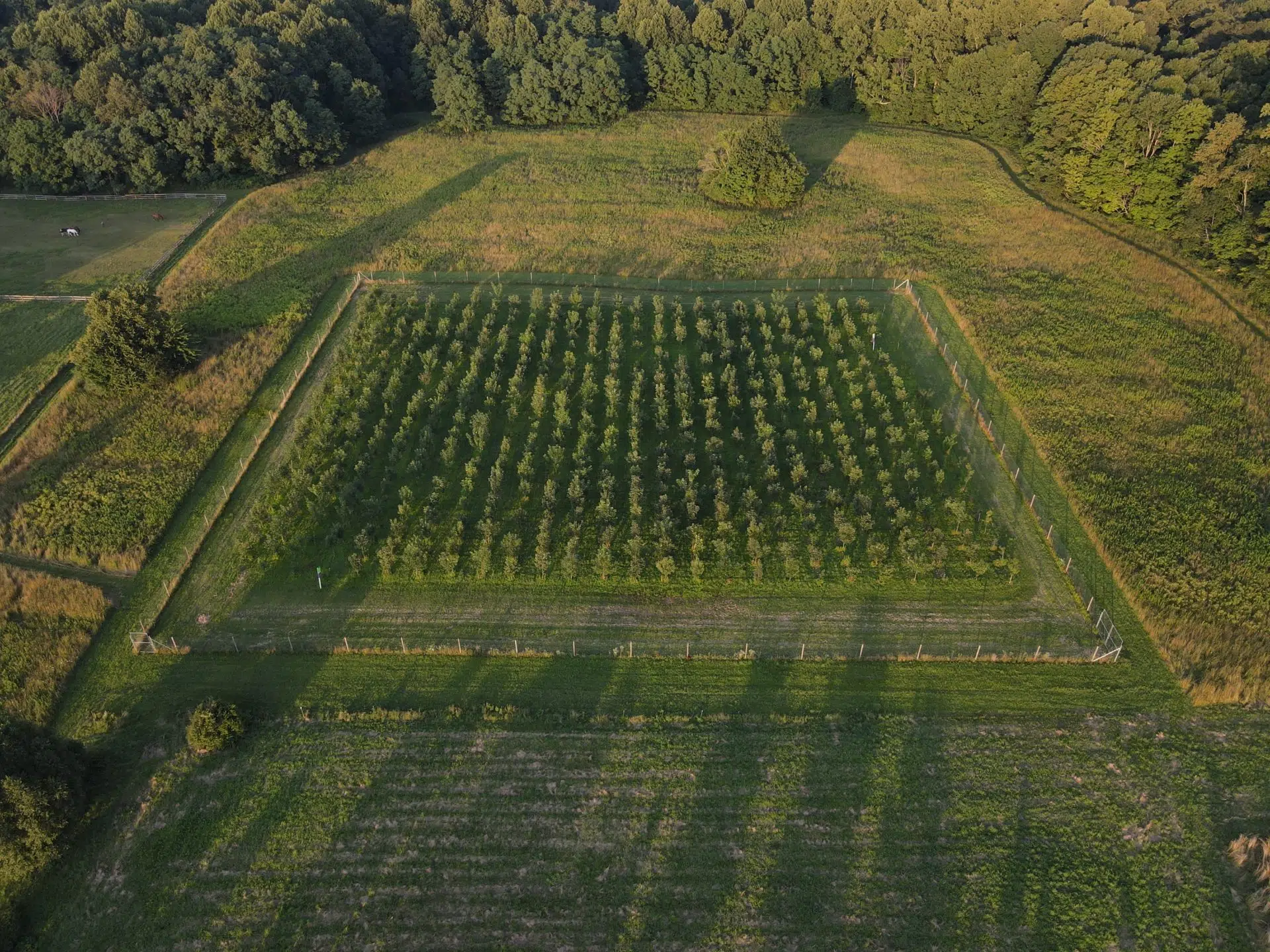
Our forests are in trouble.
Invasive insects and diseases threaten critical species like ash, elm, beech, and hemlock, especially in the Great Lakes Basin where these species grow along waterways. But some trees appear to be resistant to the pests, suggesting that widespread breeding and replanting efforts could help protect these important trees.
That’s why we launched the Great Lakes Basin Forest Health Collaborative, with funding and in partnership with the US Forest Service. We’re here to connect efforts across federal agencies, conservation groups, researchers, and members of the public who are working together to save our trees. By finding trees resistant to these threats, we can breed and replant pest-resistant trees that will ensure the sustainability of our forests for the future.
Our mission | Our trees | Get involved | Workshops | About us | Resources
Join Our Mailing List
Great Lake Basin Forest Health Collaborative Sign-Up
Our mission
The Great Lakes Basin Forest Health Collaborative (GLB FHC) supports a network of partners in tree resistance breeding activities for forest species that are threatened by invasive insects and diseases. We serve as liaison between research facilities, agencies, organizations, and members of the public, providing training and resources to help these groups reach our common goal: sustainable forests.
Breeding trees takes time and space, but it’s worth the effort to create pest-resistant trees that are locally adapted. To make this happen, our goal is to facilitate efforts of anyone interested in:
- Monitoring ash, American elm, American beech, and eastern hemlock trees
- Monitoring the spread of insects and disease
- Locating potentially resistant individuals
- Collecting and storing seeds and scions (cuttings)
- Germinating and/or grafting trees
- Planting trees for research & breeding purposes
Read our partners report: GLB FHC Partners Report 2024
Our trees
Ash (Fraxinus spp.)

Ash trees were once widespread throughout the central and eastern United States. In 2002, the emerald ash borer (EAB) was first discovered in southern Michigan, and has spread across the entire Great Lakes Region. EAB is an Asian beetle whose larvae eat the inner bark of ash trees. Hundreds of millions of ash trees have been killed by the beetle since, decimating forests.
Other health issues: Ash Anthracnose & Cottony ash psyllid
Watch our Informative Webinars:
Ash Tree Breeding and Resistance to EAB (May 2024)
New Hope for Ash: Breeding EAB Resistant Trees (Feb. 2024)
Breeding for EAB Resistance: What Does the Future Look Like for Ash Trees? (May 2022)
Watch our Training Webinar: Lingering Ash Identification & Reporting
American Elm (Ulmus americana)
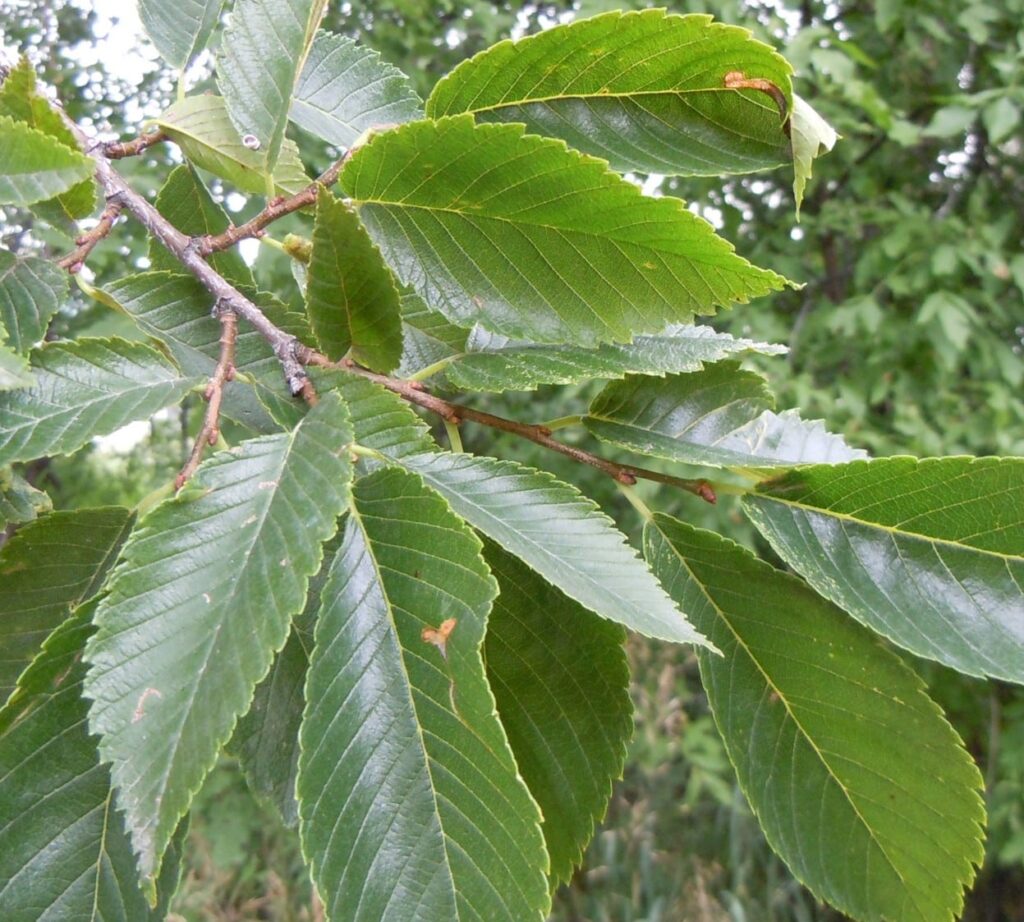
American elm can be found in many forested areas on the eastern half of the US, including those containing ash. This tree has been dealing with an invasive disease for quite a long time, Dutch elm disease is a slow fungal killer that showed up in the 1930s. The disease has spread through all of the elms range via native elm bark beetles and through elm roots, shortening the tree’s lifespan.
Read more about American elm trees
Other issues: Elm Yellows (Phytoplasma ulmi), a potentially fatal vascular disease.
Report a surviving American elm
American Beech (Fagus grandifolia)

American beech trees live across the eastern U.S., and are especially abundant in the beech-maple forests. The first documented case of beech bark disease in the U.S. was in Massachusetts in 1929 and it has spread through the Great Lakes Region. In 2012, beech leaf disease was first discovered in Ohio, caused by a nematode that damages leaves.
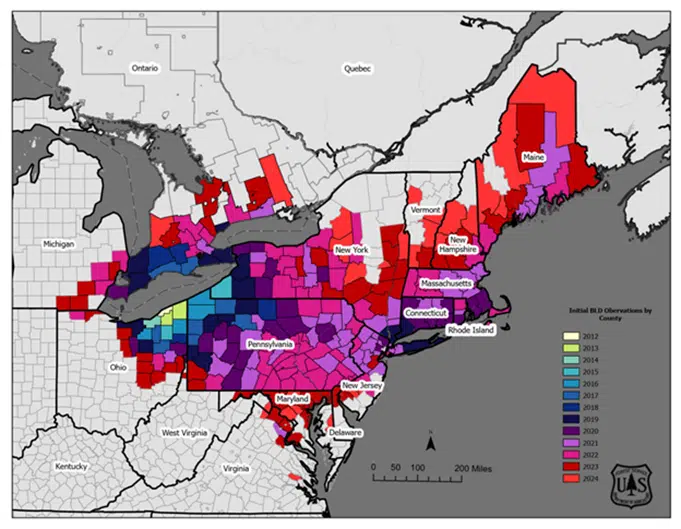
Read more about beech bark disease and resistance
Read more about beech leaf disease and beech leaf disease research
USDA FS BLD Long-term Monitoring Plot Protocol
Eastern hemlock (Tsuga canadensis)
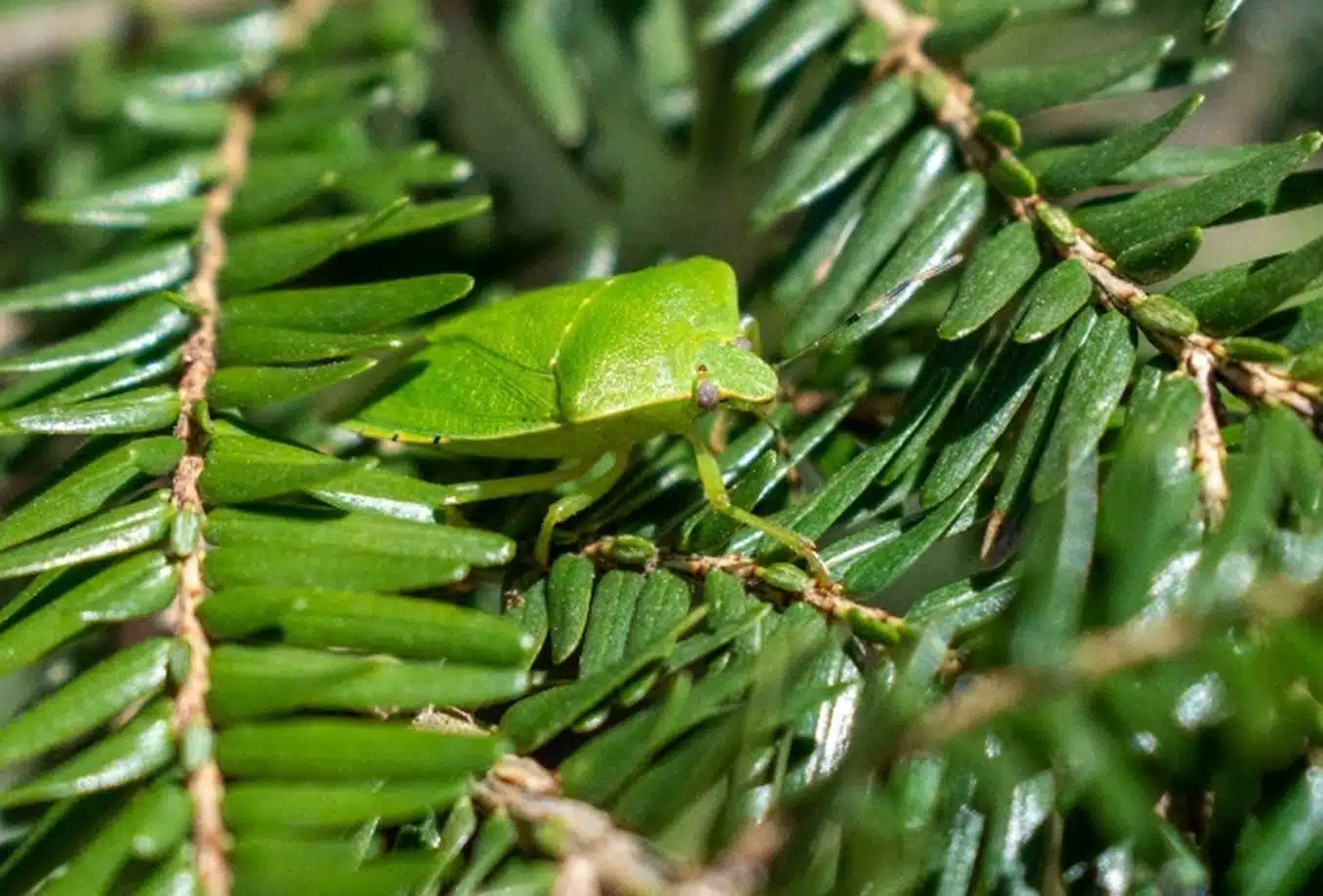
The eastern hemlock is widespread across New England, Appalachia, and the upper Midwest. The coniferous trees are threatened by infestations of the hemlock woolly adelgid, a tiny aphid-like bug that sucks the sap out of hemlocks and spruce, and the elongate hemlock scale, a tiny scale insect that can kill hemlock needles. First found in Virginia in 1951, many areas have seen over 80% tree death due to the wooly adelgid, but it can take anywhere from 2 to 20 years for an infected hemlock to die.
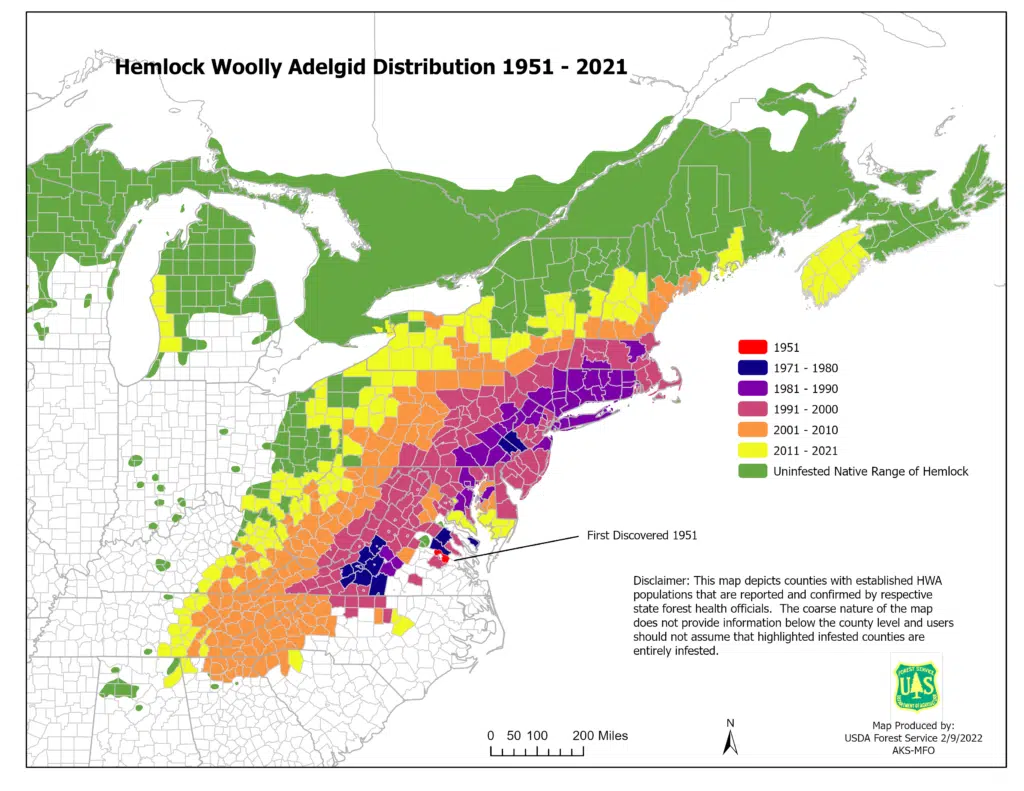
E. Hemlock range map showing what decade HWA was found, updated 2022.
View the HWA & EHS hemlock pest flyer
Watch our Training Webinar: Easter hemlock seed collection
Watch Presentations from the 2023: Lingering Hemlock Workshop
Download the Lingering Hemlock Search Protocol for professionals
Learn more about Hemlock Health Monitoring Plots
Get involved
We need members of the public to report sightings of beech, ash, and hemlock trees near them. We are particularly interested in trees that appear relatively healthy in otherwise infested areas — but all sightings of these tree species help researchers. Report your observations through the free TreeSnap app — download it today! For natural resource professionals or those who prefer not to use the app we have a Lingering Ash Form to download and email to us.
We’re also looking for organizations and individuals who are interested in assisting with:
- Monitoring forests for pest and disease progression,
- Reporting healthy trees from infested locations,
- Collecting scion and seed using best practices,
- Grafting and propagation,
- Providing greenhouse space, and/or
- Providing properties for planting trials (open space that can be fenced and mowed is ideal).
If you are interested in any of the above, please contact the Forest Health Coordinator at GLBFHC@holdenfg.org for more information about becoming a partner.
Workshops
The GLB FHC offers online training webinars and, when possible, in-person field workshops for our partners in Great Lakes states. These workshops can be done individually or combine multiple topics, and are free to partners. Contact us if you are interested in setting up a workshop for your organization!
Here are some of the workshops we currently offer:
- Forest monitoring plot set-up: Procedures on how to set up and collect data in ash, beech, and/or hemlock forested areas. Make the most of your monitoring efforts by using the same methods as the U.S. Forest Service, so your survey data are comparable to that of others across the country. Best for conservation professionals.
- Emerald ash borer trapping: Procedures on how to set up traps and collect data on EAB presence. Best for conservation professionals.
- Tree identification & surveys: How to identify hemlock, beech, and/or the five main ash species and what to look for in trees to determine if they are healthy or diseased. How to conduct forest surveys and submit observations using apps or paper forms. Best for citizen scientist groups.
- Reporting trees using phone apps: How to identify beech, hemlock, and/or the five main ash species. How to choose and use an app for reporting trees of concern or lingering ash. Best for volunteers / citizen scientist groups.
- Seed collection and germination: How to properly collect, store, stratify, and germinate ash, beech, and/or hemlock seeds. Best for conservation professionals, seed collection workshops are also great for volunteers.
- Collection for vegetative propagation: How to collect ash, beech, and/or hemlock tree samples to be used for vegetative propagation. How to perform hot callus grafting, bud grafting, and rooted cuttings, as well as best greenhouse practices for growing the trees. Best for conservation professionals.
- Establishing plantings for clone banks or progeny tests on partner properties: How to set up your own clone bank on your property or how to set up U.S. Forest Service progeny tests on your property. Best for conservation professionals.
Recorded Workshop Webinars (more to come!):
About us
The GLB FHC is sponsored by Holden Forests & Gardens and the USDA Forest Service with funding support from the Great Lakes Restoration Initiative.
Rachel Kappler, PhD, is the Forest Health Coordinator for the GLB FHC. The liaison between partners of the Collaborative, she hosts workshops, webinars, and trainings for partners to help achieve their forest health goals.
If you have any questions for the Forest Health Coordinator, please email GLBFHC@holdenfg.org.
GLB FHC’s founders are:
Holden Forests & Gardens
USDA Forest Service Northern Research Station
Thanks to our partners (in no particular order)!
- Ohio Department of Natural Resources Division of Forestry Forest Health Program
- Cleveland Metroparks
- Cleveland Museum of Natural History Natural Areas
- Morton Arboretum Resistant Cultivars Project
- Ecological Research Institute Monitoring and Managing Ash
- The National Seed Laboratory
- Northeast-Midwest State Foresters Alliance
- Camcore
- Hemlock Restoration Initiative
- Forest Resilience Alliance
- Michigan Department of Natural Resources Forest Health
- Dr. Laushman, Oberlin College
- Pennsylvania Department of Conservation and Natural Resources
- Summit County Metroparks
- The Allegheny National Forest
- Toledo Metroparks
- National Tree Seed Centre
- Dawes Arboretum
- Lorain County Metro Parks
- Sleeping Bear Dunes National Lakeshore
- New Jersey Forest Service Forest Health
- The Nature Conservancy Grand River Conservation Campus
- Wisconsin Department of Natural Resources Forest Health
- American Forests Roots of Rock Project
To see a complete list of partners with contact information click the pdfs below:
Active Partners – those who organize resistance breeding related activities
Networking Partners – those who are interested in starting related activities
Resources
- Grants List above has details on grants that partners may be interested in applying to
- Seed collection and conditioning workshops at the National Seed Laboratory
- Genetic conservation with the National Seed Laboratory
- Ash seed collection resources from the National Seed Laboratory
- TreeSnap app
- Lingering Ash Report Form
- Tree Health Survey User Manual — reporting beech leaf disease
- GLB FHC Flyer
- GLB FHC Partners Report 2021-2023
- Newsletter Archive
- Feb 20, 2025: Quarterly Newsletter
- Nov 19, 2024: Quarterly Newsletter
- Aug 19, 2024: Quarterly Newsletter
- May 28, 2024: Quarterly Newsletter
- Feb 22, 2024: Quarterly Newsletter
- Nov 16, 2023: 4th Quarter Newsletter
- Aug 15, 2023: 3rd Quarter Newsletter
- May 19, 2023: 2nd Quarter Newsletter
- Feb 17, 2023: 1st Quarter Newsletter
- Nov 18, 2022: Quarter 4 Newsletter
- Aug 25, 2022: Quarter 3 Newsletter
- May 25, 2022: Quarter 2 Newsletter
- Feb 20, 2022: Quarter 1 Newsletter




